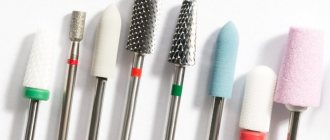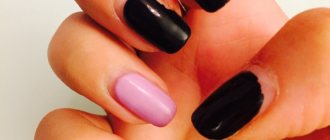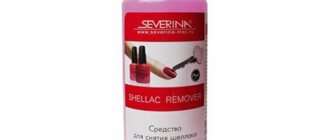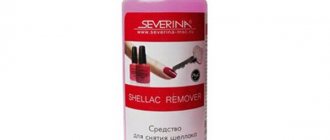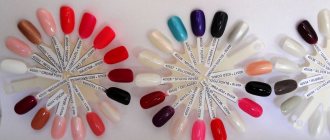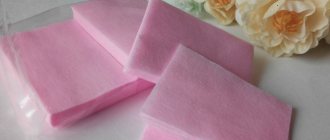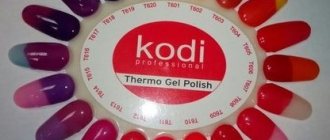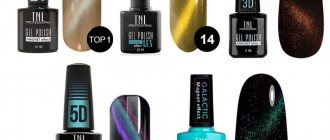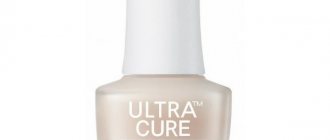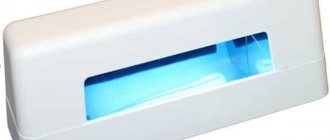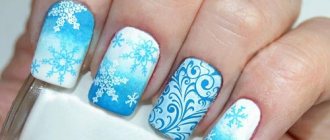The cutter for removing gel polish can be spherical, cone-shaped, metal, ceramic and other types. Each of them has an individual purpose, but they are all needed to perform a high-quality manicure.
The technique of removing decorative coating involves making light, stroking movements from the cuticle to the end of the nail. The middle of the nail is treated with wide nozzles, the sides of the plate with narrow ones. Silicone tips are used only for polishing the surface of the nail (base layer) before applying a new layer of gel polish or shellac.
The cost of cutters is variable, ranging from 150-450 rubles and depends on the materials, shapes, sizes and reputation of the manufacturer.
What is a cutter for removing gel polish?
A cutter for removing gel polish is a rotating tool that is equipped with a sharp tip. It works in a machine that is designed to perform standard hardware manicure. The cutter changes depending on the tasks assigned (it is available with different notches and degrees of abrasiveness), and rotates at high speed.
If an experienced professional uses the machine, then it takes a minimum of time to remove gel polish with a cutter - no more than 15 minutes for both hands. The procedure cannot be carried out in this way if:
- severe dystrophy and excessive sensitivity of the nail plates;
- existing allergy to dust in the master or female client.
Another disadvantage of using a cutter to remove gel polish is the high cost of the machine for hardware manicure and the actual rotating attachments, and using cheap equipment for this manipulation is strictly not recommended.
Pros and cons of hardware removal
Hardware removal of gel polish has a number of advantages:
- There is no risk of damaging your nails. Thus, the liquids used to remove the coating contain acetone, an aggressive substance that dries the nail plate and leads to cracks. In addition, when removing the gel with a nail file, there is a risk of accidentally touching the top layer of the plate and damaging its structure.
- Save time. Removing shellac with a machine takes on average 10-15 minutes, while the manual method takes more than an hour.
The disadvantages of hardware work include technical features: skills in working with equipment, correct direction of movements, etc. In addition, using the device also requires additional costs for the purchase and replacement of cutters or repair of the device.
What are the advantages of removing gel polish with a machine?
The advantages of removing gel polish with a device include:
- maintaining the density and structure of the nail plate - gel polish removers dry out the nails greatly, which leads to their rapid delamination;
- no contact of the cutter with the surface of the nail, so damage is excluded;
- complete preservation of the base layer of the coating, which prevents the negative impact of external factors on the nail.
The main advantage of the method is the refusal to use removers, which aggressively affect not only the gel polish, but also directly on the natural nail plate. Experts say that thinning, separation and brittleness of nails after a manicure with gel polish do not appear after the use of such specific materials for decorative coating, but against the background of the use of liquids to remove it.
Types of cutters
Made from hard metals. Carbide cutters, unlike others, during operation transform the removed varnish not into dust, but into chips. Good for correcting nails and removing thick layers of varnish. They work quickly and do not heat up. It should be borne in mind that when working with gel, metal cutters with fairly large notches are required, otherwise the plastic gel will clog the tool in a short time. The configuration of the notches can be straight, inclined, or cross-shaped.
The new generation of cutters for removing gel polish is made from ceramics with a complex composition: in addition to special clay, it includes feldspar, quartz, and bone ash. The result of firing is an unusually durable material. The cutters from it remove the varnish coating gently, without the slightest vibration and in a short time. They are 3-4 times more durable than metal cutters. The notched tool is shaped like an ear of corn.
What types of machines are there for removing gel polish and shellac?
Depending on the purpose for which the machine for removing gel polish and shellac will be used, you can purchase home or professional equipment. The first option has the following characteristics:
- compact dimensions;
- low power;
- minimum set of cutters (no more than 10 pieces);
- The quality of the attachments is average.
It will be problematic to quickly and efficiently remove gel polish or shellac with home machines, because their cutters wear out a lot.
Professional gel polish remover machines have:
- high power;
- automatic tip ventilation;
- reverse and direct rotation of cutters;
- a large set of attachments (more than 10 pieces);
- the ability to work in different modes and independently adjust the speed of rotation of the nozzle.
It is professional equipment that allows you to work in “emergency” mode and cope with any type of decorative coating.
Watch this video about which manicure machine to choose:
Are there any for left-handed people?
For left-handers, manufacturers introduce special cone-shaped or cylindrical cutters, which are distinguished by a cross cut. Carbide cutters are optimal for left-handers - they are universal and work equally effectively in both forward and reverse rotation.
If it is necessary to treat areas of the lateral skin folds and cuticles, left-handed people will benefit from streamlined ceramic attachments.
Recruitment of a specialist
What you need to remove gel polish with a manicure machine:
- router and attachments (cutters);
- brush for cleaning dust and chips;
- orange wood sticks (you can use a scraper);
- cotton pads or smooth napkins;
- face mask against dust and shavings;
- regular nail file;
- buff for polishing;
- warm oil to soften and nourish nails and cuticles.
Set of nozzles
Which cutter to remove gel polish with, their main types
You can remove gel polish with different cutters; masters distinguish three main types of them, which differ in shape:
- Globular . Used for processing cuticles, the diameter ranges from 1-2-3 mm. A spherical cutter ideally processes the cuticle and the nail near it; it can also be used to level the surface of the plate and get rid of tubercles and roughness. Disadvantages of this type of attachment: it cannot be used to remove gel polish from the entire nail; if you press hard while working, it is easy to make a cut.
- Kidney-shaped . Used to treat the nail plate and lateral skin folds, remove pterygium and cuticle. This type of cutter has three subtypes - “flame” (used exclusively for removing the cuticle and removing pterygium), “willow” (allows you to easily process the nail folds), and “lentil” (rough skin near the nail folds is processed). You can remove gel polish with a kidney-shaped cutter, but only with the lower part of the nozzle.
- Conical . It can be truncated, regular, with a rounded end, or needle-shaped. All varieties are suitable for removing gel polish; they also allow the master to level the surface of the nail plate and correct its shape. A conical cutter makes it possible to treat ingrown nails.
Ceramic
A ceramic cutter has several notches of different depths, can be soft, medium and hard, and is available in oval and/or cylindrical shapes. Advantages of using this type of gel polish remover:
- long service life - they can work 3-4 times longer than all others;
- low vibration - there are no shavings during sawing, only the smallest dust is formed, there is no discomfort for the master and the client;
- minimal heating of the plate - you can remove the decorative coating without braking or reducing speed.
The rotation speed is 20 thousand revolutions per minute, the service life of one cutter with maximum active use is 2 months, and these parameters compensate for the high cost of the nozzle.
Metal, steel
Metal cutters are made of tungsten or carbide, but they are never used to remove gel polish. These cutters are suitable for processing rough cuticles and pterygium when performing pedicures. Advantages of a metal cutter:
- effective against calluses (relevant for pedicures);
- do not corrode even with active use;
- respond adequately to disinfection even with aggressive agents;
- remove a layer of 1 mm in one pass over the problem area.
The only drawback of a metal cutter is the high risk of exceeding the permissible rotation speed of the product. Service life is six months, maximum speed is 15 thousand per minute.
Carbide
A carbide cutter is made of metal and has several notches on its surface - their depth depends on the hardness of the nozzle. Notches can be straight, oblique and spiral. "Pros" of using a carbide cutter:
- The hardest layer of gel polish is quickly and efficiently removed;
- makes it possible to make recesses for installing rhinestones;
- effectively files the end of the nail.
The technician must carefully monitor the speed of the nozzle in the device, because exceeding the permissible values increases the likelihood of injury to the nail plate and skin significantly. The service life of the carbide nozzle is a maximum of 4 months, the rotation speed is no more than 15 thousand revolutions per minute.
Diamond
Such cutters have a base on which diamond coating is applied with microparticles - the larger they are, the harder the attachment will be. There are two subtypes of diamond cutters:
- sintered - diamond shavings are applied to the base of the nozzle and then baked in an oven, resulting in a solid tool that has a long service life;
- monolithic - diamond particles are applied to the base using glue in several rows and only after that the tool is placed in the oven, a round-shaped attachment is obtained.
The advantages of using diamond cutters include:
- the ability to remove not only gel polish, but also acrylic decorative coating;
- optimal for cleaning side rollers;
- There are different shapes and sizes of diamond bits available in the market.
The only drawback of a diamond-coated cutter is the need for frequent and thorough cleaning, because the notches are heavily contaminated with dust from gel polish/acrylic/shellac. Rotation speed – maximum 26 revolutions per minute (minimum 18), cutter service life – no more than 4 months.
Cotton or silicone
Such attachments are optimal for beginners - they are soft and can be used for delicate treatment of the nail plate. You won't be able to remove gel polish or shellac with a cotton or silicone attachment, but you can use them to properly treat the surface of the nail and get rid of roughness, bumps, stripes and any irregularities.
Cutters of this type can be spherical or cone-shaped. Experienced professionals recommend purchasing several types of silicone and cotton attachments at once.
Corundum
Made from a synthetic material resembling ceramic chips. A distinctive feature of a corundum cutter is that it does not overheat during operation, which significantly reduces the likelihood of injury to the skin and nail plate. Such attachments are available with coarse and fine abrasive surfaces - the former are necessary for treating wide areas of nails, the latter for cleaning rollers and cuticles.
Advantages of using corundum cutters when removing gel polish:
- You can carefully treat even thin cuticles;
- multifunctionality - you can remove the decorative coating and clean the skin around the nail;
- high strength of the nozzle - does not deform even at high temperatures;
- the material is classified as hypoallergenic.
The disadvantage of the corundum nozzle is the need for frequent washing, since the notches on the surface are tightly clogged with dust from the sawed-off gel polish. Small cutters (with low abrasiveness) are used at a speed of 26 thousand per minute, medium and large (with high abrasiveness) - 12 thousand per minute. Service life under active loads is 3 months maximum.
Corn
Corn is a cutter with many notches over the entire surface. It can be made of ceramics; there are also carbide tips of this type. This type of cutter quickly and efficiently removes gel polish and shellac of any hardness, but can also be used for processing the nail plate (leveling), stripping the cuticle and skin side ridges.
The cutter has a streamlined shape, and if the coating is finely abrasive, then it can process both the cuticle and skin ridges, but at a speed of no more than 15 thousand per minute.
Green and other colors
It is important to know other parameters of the nozzles, which differ in color:
- green;
- yellow;
- red;
- blue;
- black.
The darker the color, the harder the cutter and the higher the abrasiveness of its surface. For example, black will be the hardest, but green will be universal, its hardness/abrasiveness indicator is average. When choosing, professionals recommend paying attention to the labeling of a specific manufacturer, because their indicators may differ.
The color does not mean the entire cutter, but the strip located directly at the nozzle, at its wide edge, on the rod.
Watch this video about the types and purposes of manicure cutters:
Types of cutters
Depending on the material from which the cutter is made, the tool can be ceramic or have a metal base. The first option is cheaper. Also, cutters differ in rigidity, which is indicated by markings on each tool.
The information is presented in the table:
| Color | Rigidity | Usage | Abrasiveness |
| white | the softest nozzle | used for working with sensitive skin or when correcting minor imperfections on the nail plate | up to 5 microns |
| yellow | soft nozzle | recommended for working with natural nails, as well as for sensitive and thin skin of the client | 15 µm |
| red | soft nozzle | used for manicure or sensitive nail plate | 30-50 microns |
| blue | medium hardness | These cutters are used to perform manicures. They do not work on the nail plate. Rarely used to remove soft colored coating | 90-125 microns |
| green | tough | Designed for removing gel polish or rough coating (acrylic, gel, acrylic). Not suitable for clients with sensitive skin or excessive sweating | 125-181 microns |
| black | the hardest cutter | The master works only with extended nails | 1 strip – 300 µm, or 2 strips – 500 µm |
Important! The speed of the cutter depends on the material from which it is made. If the number of recommended revolutions is exceeded, the nozzle deteriorates and becomes unusable: it bends, begins to “beat”, and does not perform its functions. The following rule applies: for a larger cutter diameter, lower speeds are turned on.
Metal
Such products are made of carbide or tungsten. Steel cutters are not used to remove gel polish. They are used to treat rough cuticles and remove pterygium in pedicures.
Advantages:
- copes well with calluses;
- do not rust during operation;
- can be disinfected with chemicals;
- remove a layer up to 1 mm.
The disadvantage of the product is that if the permissible number of revolutions is exceeded, there is a risk of injuring the client or damaging the cutter pin. Operating speed – up to 15 thousand rpm. Service life – 6 months.
Carbide
Cutters for removing gel polish of this type are made of metal and have notches on the surface. The harder the cutter, the deeper the cut. Accordingly, the roughest tool leaves unevenness (notches) on the nail. The cutters can be with straight, oblique, or spiral cuts.
Advantages of the tool:
- you can quickly remove gel polish;
- used to make holes for rhinestones or piercings;
- You can use a cutter to file your nail.
Flaws:
- you need to pay attention to the number of revolutions;
- If safety is not observed, it can harm the client.
Operating speed – up to 15 thousand rpm. Service life – up to 4 months.
Ceramic
This cutter is made of ceramic, it has serrations of different depths, it can be soft, medium and hard. It can also be shaped like an oval or cylinder. Care is required during use, as the cutter may fall and crack or break off a piece.
Benefits of use:
- long service life. Ceramic nozzles can work 3-4 times longer than metal ones;
- softness when removing gel polish. The ceramic tool vibrates less, which makes the work pleasant, and the number of negative sensations for the client is reduced to a minimum. During sawing, fine dust is formed, there are no large particles - shavings;
- less heating. Using a ceramic cutter, the master can remove the color coating at high speeds without interrupting the cooling of the nail plate.
The disadvantage is the high cost. But it is compensated by a long period of use. Operating speed – up to 20 thousand rpm. Service life – 2 months.
Corundum
The cutter is made of synthetic material, which in appearance resembles ceramic chips. They are resistant to high temperatures and do not heat up during use. Corundum bits do not indicate the degree of abrasiveness, so you need to be careful when choosing.
Kinds:
- wide with coarse abrasive - used to treat large areas and prepare the nail for extensions;
- tapered with low abrasive - used for processing rollers and thin cuticles.
Advantages:
- the ability to accurately process thin cuticles, since the cutter belongs to the grinding class;
- multifunctionality. The nozzle can be used not only for grinding, but also for processing cuticles, correcting length and shape, removing detachments;
- strength. The material is heat-resistant and elastic, so the cutter does not deform;
- hypoallergenic;
- can be used to remove calluses.
Disadvantage - it is necessary to constantly rinse thoroughly, since small particles accumulate inside the abrasive. The operating speed of small and medium cutters is up to 20 thousand rpm; large nozzles are not used at more than 12 thousand rpm. Service life – 3 months.
Diamond coated
Such nozzles have a base onto which diamond shavings are sprayed. Depending on the size of the particles, the abrasiveness of the tool changes - the larger their size, the harder the cutter.
Diamond cutters are:
- sintered – diamond particles are applied to the nozzle and baked in an oven. This results in a one-piece tool that lasts longer;
- monolithic - diamond particles are applied to an adhesive base in several rows and then baked. The choice of such cutters is limited. Since the method does not allow you to make a nozzle with a thin tip, it is always rounded.
Benefits of use:
- possibility of working with acrylic;
- can be used for cleaning side rollers;
- variety of shapes, abrasives, sizes.
The disadvantage is that it must be thoroughly cleaned, since the notches become clogged with sawdust from the nails. Operating speed – 18-26 thousand rpm. Service life – 3-4 months.
How to remove gel polish with a manicure machine: technique
To avoid damage to the nails when removing gel polish with a manicure machine, the manipulation technique must “obey” the following rules:
- The master's elbow must be securely fixed. It is better to rest it on the table/work surface, then the risk of the cutter slipping off the nail is eliminated.
- Remove the gel polish with gentle smooth movements, stroking - first the nozzle approaches the nail, then it is removed. This technique significantly reduces the likelihood of plate overheating.
- The process of removing the decorative coating begins from the middle of the nail, movements are performed slowly. When processing the outer sides of the nail, the movements should imitate sawing.
- The router is never held strictly vertically; it is slightly tilted for safe operation. You should work not with the tip of the nozzle, but with its middle part.
- All movements are performed strictly according to the movement of the cutter. Otherwise, the tool may slip off the nail plate, and this leads to chips of the base and cuts.
- You cannot use manicure attachments as a cutter for removing gel polish, as well as vice versa. Each tool is used for its intended purpose.
- Rhinestones can be cut only with a diamond-coated cutter.
- If the gel polish is removed with a ceramic tool, the technician must wear a mask - this will protect the respiratory tract from the penetration of the smallest dust particles.
- As soon as the layer of decorative coating is removed and the base becomes clearly visible, work with hard cutters should be stopped. The next stage is grinding and polishing the plate with a silicone or cotton nozzle.
Watch this video on how to remove gel polish with a machine:
Which cutter to use for manicure
For manicure, without removing gel polish, you can use the following types of cutter attachments:
- ceramic – you can work with hard nails and cuticles;
- diamond – remove pterygium (a thin layer of skin on the nail near the cuticle);
- metal – excellent for cleaning side rollers;
- silicone, cotton, combined - can be used from the beginning to the end of the process.
The craftsman should have a wide variety of cutters; their various shapes are also useful - cone/reverse cone, needle/ball, bur.
How to avoid damaging your nails
Many people are concerned about the question: how to remove gel polish from nails with a device and not damage them? While the cutter is working, the gel polish is removed from the nail layer by layer. First, the top coat is removed, then the color layer, leaving the base coat. In some cases it is also removed, but this happens extremely rarely.
The artist focuses on the base coat, which usually has a slightly matte, transparent appearance. This layer signals that it is time to stop removing material. If you still need to remove it from the nails, this can be done with a file and a buff, or, if the material is soluble, using an acetone-containing liquid.
The most dangerous place where marks from a cutter can remain is the cuticle area. The nail here is weaker, and even one careless movement can leave a mark, which will then take a long time to grow back. Therefore, some people prefer to work near the cuticle with the upper part of the cutter, where the cuts are very small.
How to remove gel polish with a machine yourself at home
You should remove gel polish yourself at home using a device according to a clear algorithm:
- Remove topcoat and decorative/color coating. The movements are performed long, longitudinally, in the direction from the cuticle to the end of the nail. The speed is optimal, only the middle part of the plate is processed, the middle part of the cutter is used in the work (the most convex part - the “belly”).
- Move to the side parts of the nail and remove the gel polish here with the tip of the cutter. The rotation speed of the tool does not decrease; you need to monitor the pressure - it should be uniform, without applying any effort.
- The end of the nail (free edge) is processed with the middle of the cutter; it should not be positioned vertically in relation to the plate, but at an angle of 10-15 degrees. This completes part of the work of removing the decorative coating.
- Clean the base layer with a cone-shaped corundum cutter. The speed should be reduced to 10 thousand per minute.
- The final stage is to walk over the surface of the plate with a buffer with an abrasiveness of 240 grit without applying any effort (without pressure).
Watch this video on how to remove gel polish with a machine at home:
Safety instructions
Before removing gel polish with the device, you should read the instructions:
- Before turning on the device, a visual inspection is carried out to ensure timely detection of damage. If they are present, the device cannot be turned on.
- You should insert the nozzle all the way, only then turn on the device.
- Periodically during operation, turn off the power and cool the device. Failure to comply with this requirement will result in overload and damage to the device.
- If unusual vibration occurs, turn off the device and call a repair technician.
- Do not operate the device in high humidity or with wet hands.
- Avoid heating the electrical wire from a radiator or direct sunlight.
- Contact of the device with chemical compounds should be avoided.
During operation, you have to change attachments. This should be done with the power off.
How to remove a cutter from a manicure machine
The cutter is removed from the manicure apparatus using different methods, which differ depending on the type of attachment clamp in the apparatus.
Manual clamp
Typical for cheap equipment intended for home use without active use. The mechanism consists of a button and a washer. To remove the cutter, you need to press the button (it is located on the handle body) and unscrew the washer - the attachment will easily come out. To install a new one, you need to press the button again, insert the desired tool and tighten the washer.
The manual clamp is not intended for frequent use; if you constantly change attachments, the equipment will simply break.
Semi-automatic clamping
A special feature of this type of fastening is the presence of a collet, which is a split sleeve (the nozzle is clamped in it). In order to remove the cutter, you need:
- Make a half turn with the ring (upper part of the handle) until a characteristic click appears.
- Remove the cutter without changing the position of the ring.
If you need to insert a new nozzle, then to clamp it you need to turn the ring half a turn in a counterclockwise direction.
Semi-automatic clamps are the most common in manicure machines.
Automatic clamp
The nozzle is clamped in its working position automatically when the device is turned on, so to remove the cutter you just need to disconnect the equipment from the power supply and pull the cutter towards you.
This clamp provides the easiest way to change manicure attachments and get rid of decorative coatings such as gel polish or shellac. It is installed on expensive equipment.
Watch this video on how to insert a router bit into the router handle:
Auxiliary tool for removing gel polish
It is quite possible to remove gel polish only with a cutter, but to carry out the entire manipulation efficiently and properly prepare the nail plate for applying a new decorative coating, you will need other tools:
- orange stick – cleans the inner surface of the nail, moves the cuticle, removes too thin cuticles;
- nail scissors - cut the cuticle and side skin ridges (if they are especially rough);
- metal spatula - pushes back the cuticle, cleans the subungual space from dirt, cleanses the pterygium.
It is highly desirable that the master’s workbench is equipped with an extractor/vacuum cleaner - when removing gel polish with cutters, a lot of dust is generated, which can cause coughing, shortness of breath and allergies. Its instant removal is a comfort for both the master and the client.
Basic principles
Every girl should know that under no circumstances should you rip off the peeling coating “live.” Gel polish penetrates into all microcracks of the nail plate. If you simply rip it off, you can seriously damage your nail. If you think that after coating your nails begin to peel and cracks appear, then you are deeply mistaken. This happens after it is removed incorrectly.
The master will do this painlessly and professionally, but if you really want to, you can learn the removal technique yourself. To do this you will need some equipment, a little time, and some knowledge.
- Before starting work, always remove the top, glossy layer with a medium-hard buff.
- After treatment, lubricate the cuticles with nourishing oil and use hand cream.
- It is advisable to wait several days after removing the old coating before applying a new one, so that the nail plates have time to be enriched with oxygen. After all, under the gel his access to them is limited.
- Please note that in a cold room, the coating is more difficult to remove from cold hands, so warm both before work.
Let's take a closer look at how to remove gel polish at home, look at educational photos and videos.
At what speed should you remove gel polish with the machine?
It is imperative to monitor the speed when removing gel polish with the device: 12 thousand revolutions per minute is considered optimal for ceramic attachments, and 20 thousand per minute for carbide, metal and others. Professionals recommend using a speed of 30-40 thousand revolutions per minute, which will prevent the nail plate from heating up.
Beginners can stop at 30 thousand revolutions per minute to avoid damaging the client's nail plate or skin.
Rules for working with the device
When operating the device, certain rules must be followed to avoid injury. You need to familiarize yourself with them before removing gel polish with the device:
- The rotation speed is set on the control panel. To do this, use the regulator, smoothly switching it.
- During operation, the rotation of the cutter is controlled by a pedal. By pressing it all the way, the speed set on the relay is achieved. To reduce it, you can ease the pressure on the pedal or switch the relay.
- The direction of rotation should be changed in three stages:
- Take your foot off the pedal.
- Wait until the rotation stops completely.
- Switch direction of rotation.
During operation, the rods of the nozzles may become damaged (rust, dirt). Continued use of them leads to wear of the motor bearings.
The device should be stored with the rod inserted and should not be turned on without the attachment.
How to clean a cutter from gel polish
You need to clean the cutter from gel polish after each use; the process is performed in the following order:
- Wipe the attachments with a napkin or small brush to remove dust and skin flakes. This is done “dry”, without the use of water or any antiseptic solutions.
- Disinfect cutters with special solutions Estilodez, Gigasept, Optimax. They are certified, contain anti-corrosion additives, and have antimicrobial, antiviral and antibacterial effects.
- Wash the cutters in a solution with detergent. Dry with cloth or thick paper napkins by blotting.
- Sterilize the attachments. This can be done in an autoclave, glasperlene apparatus or dry-heat oven, but these options are only suitable for salons. At home, you can use the oven as a sterilizer, after first cleaning it of grease and dirt.
The cutters are kept in disinfectant solutions for no more than 20 minutes. When sterilizing in the oven, the attachments are laid out on a baking sheet covered with foil. The oven is heated to 180-200 degrees, the holding time of the attachments is 20 minutes, after which everything is turned off, and the cutters remain in the oven for another 20 minutes.
For home processing of attachments, you can use special craft bags: the instrument is placed in them, they are sealed, and only after that they are sent for sterilization. There is a strip on the surface of the craft bag that changes color at a certain temperature - this indicates the sterility of the cutters.
How to choose a gel polish remover
When choosing a gel polish remover, you need to consider the following nuances:
- weight of the device - 100-200 g is considered optimal, which makes the handle of the router almost weightless and greatly facilitates the work of the master;
- vibration level - the lower it is, the less the master’s hand will get tired, the less noise there will be from the equipment;
- number of revolutions (power) – 30-35 thousand per minute is considered optimal;
- type of cutter clamp - can be manual (suitable for home use), automatic and semi-automatic;
- a set of attachments - a novice master can use a minimal set, an experienced one will probably buy them individually, focusing on his own needs.
Cost of cutters
The cost of cutters depends on the material from which they are made, the “name” of the manufacturer and retail outlet, but the average values are as follows:
- diamond cylindrical with a round tip – 150 rubles;
- ceramic type “corn” with a blue stripe – 450 rubles;
- silicone polishing – 150 rubles (size 15 mm);
- carbide “needle” – 200 rubles;
- “corn” carbide with red or blue markings – 300 rubles;
- felt (cotton) nozzles, set of 6 pieces – 200 rubles.
We recommend reading about what you need to know when choosing a gel polish lamp. From the article you will learn why you need a lamp for gel polish, how it works, and how to choose a lamp for drying gel polish. And here is more information about how to remove shellac at home.
Removing gel polish with cutters is considered a safe, quick way to remove decorative coating before a new manicure. A competent choice of attachments and the correct technique for performing manipulations allow even beginners in the nail industry to do a high-quality manicure. And subsequent disinfection of the cutters and their sterilization makes the process safe even when serving numerous clients.
Hardware removal of shellac
Using a router and special attachments, you can remove the coating at home. To do this, you will need a device, ceramic attachments for treating nail plates, and metal ones for treating the cuticle area.
Step-by-step instruction
Wash your hands and dry them. The device treats dry fingers without cosmetics. If you are new to this business, read up on which attachment is intended for what. Practice grinding the surface with tips or plastic, watch training videos. After you fully understand the purpose of the nozzles and at what angle to hold them while working, get down to business.
Remove top and color with a ceramic nozzle. Treat the cuticle area with a metal, softer one. After removing the color, sand the surface with a softer pad. If necessary, remove cuticles, make nails of the desired shape and size using tongs and a nail file. Then apply colorless varnish and treat your fingers with nourishing oil. It is better to give them a few days to rest, and only then apply shellac again.
There are many types of milling machines. For home use, you can purchase a simplified model if you do not plan to use it daily.

